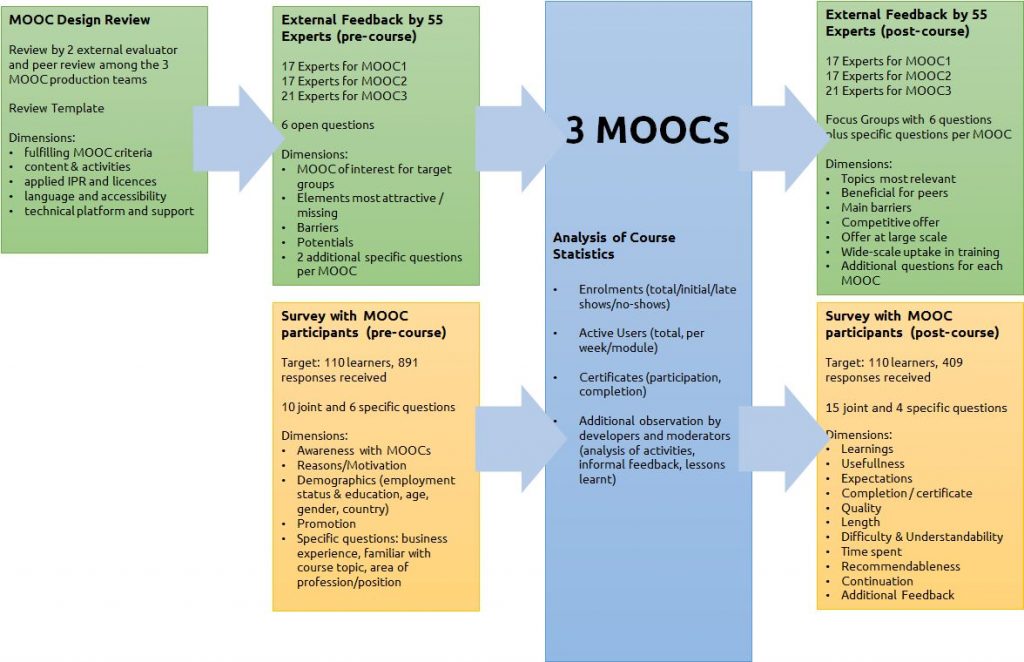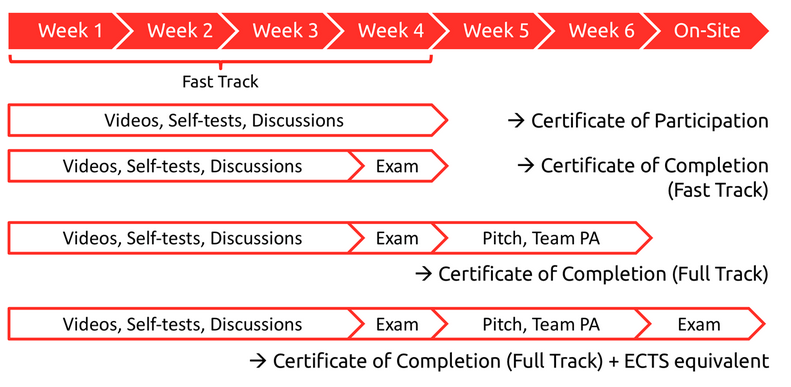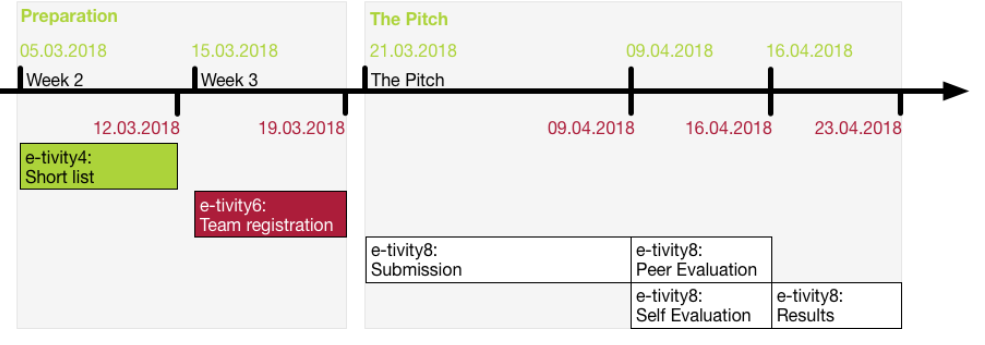12
There are many different elements to consider when putting together a MOOC! We have 20 suggestions for good practice that will help to keep you on track.
1. Learning Design Principles and Tools for MOOCs
Develop the structure and content of the MOOC using proven learning design principles and tools. There are existing, tested templates available to be used by anyone. The BizMOOC team used the design templates and methodology of The Open University. A video instruction to the Learning Design process is available from https://www.youtube.com/watch?v=tA5K7nlQ2e0.
2. Templates, Questionnaires and Surveys to Identify Your MOOC Target Group
Conduct research on the characteristics and needs of the target groups in the early phase of the design process. Using this information to design the MOOC should enable you to engage appropriately with as many learners in target audience(s) as possible. For example, the BizMOOC project started with interviewing both higher education institutions and business representatives to get a broad overview of the gaps and insights to needs of the target groups. It also exposed the level of familiarity of target groups with MOOCs, their presumptions, reservations and expectations. Feel free to apply the templates, surveys and questionnaires used in BizMOOC (which are available on an open licence). They can be downloaded from http://mooc-book.eu/index/learn-more/further-readings/.
3. Prototyping in MOOC Design
Involve experts, learners and peers in the evaluation of the design and course prototype well in advance of its launch. Anticipate several rounds of review and iterative improvement.
4. Schedule Time for MOOC Design!
Take sufficient time for the design of the MOOC. This pays off significantly during the development of the course. In our project, we started one year in advance of the MOOC’s launch by defining course and learning objectives, target groups and developing an initial plan. There was straight-forward time plan (using a GANTT chart), a Project communication plan including a formal Kick-Off Meeting in combination with a workshop on MOOC didactics, regular online meetings, clearly defined milestones and a blue print in place.
5. Linguistic Tools for Translating MOOCs
Use linguistic tools to overcome language issues. A bilingual course might be a good option to overcome language barriers and engage with a larger number of potential and/or actual users. There are machine translation options for MOOC, such as the EU-funded project TraMOOC (tramooc.eu), for example. Even YouTube has semi-automatic subtitling options or one could use Google’s subs – but these will need checking and correction manually.
6. Balance Out Unequal Experience Levels within MOOC Design Teams
Acknowledge and address unequal knowledge and experience with MOOCs within the design team. The BizMOOC project had MOOC teams from various background and sectors, some with hardly any previous knowledge on MOOCs. This was addressed by first producing 14 state-of-the-art papers with contributions from all team members. These papers were then reviewed by MOOC experts. In addition, a dedicated learning design workshop was held next to overall team guidance by work-package leaders experienced in MOOC development and implementation
7. Use a Course Planner Sheet to assign tasks and responsibilities
Assign tasks and responsibilities according to team member’s areas and levels of expertise in support of an overall vision.
8. Quality Dimensions Review
Establish the goals, learning outcomes, characteristics and quality criteria of the MOOC before developing the MOOC. Consequently, MOOC team members should be aware of the main priorities and concerns when developing and implementing a MOOC. In the BizMOOC project, this was not only facilitated by the learning design workshop, but also by discussing the quality dimensions and criteria that apply to the project overall and the specific target group of the MOOCs.
9. Key Performance Indicator Dashboard
Select and measure key performance indicators that are most appropriate for the MOOC. During the design phase, the BizMOOC project discussed the key criteria that guarantee the quality of each MOOC. As part of this process many pre-existing quality checklists, questionnaires for experts and MOOC participants and other tools were re-used.
10. MOOC Evaluation Design
Plan the overall evaluation and quality process, including who will review what elements using which template with applicable criteria, beforehand. In the BizMOOC project, we agreed to have a review of the MOOC design by two external experts and by the two other MOOC teams. In addition, feedback was collected from 55 experts pre-course (open questions in survey) and post-course (focus group sessions) and by MOOC participants by pre- and post-course questionnaire. In the graphic below you can see how this process was designed in the BizMOOC project.

Table 4: Quality Review in BizMOOC
11. MOOC Platforms
Review a range of MOOC platforms and carefully select one to ensure that the chosen platform is accessible for the identified target groups (e.g. can be utilised by businesses or Higher Education Institutions), has the functionality you require for the course and is easy for learners to sign-up to and navigate. Some platforms enable learners to track their progress which can have a strong motivational impact.
12. Make MOOC Content Accessible
Ensure the accessibility of content and assets (such as videos) on different devices when developing your MOOC. For example, subtitling videos or providing text that is in a screen reader compatible format or making content accessible on mobile devices.
13. Think About Licensing
Consider the medium- to long-term life of the MOOC. For example, by openly licensing course content and/or by using open education resources (OER) you enable re-use and further development of the course by both yourself or others.
14. Flexible Course Tracks
Whenever necessary, introduce flexible course options (fast track and full track): This functioned well and was appreciated by the learners of our MOOC Pilot 3 on Intrapreneurship . Learners were motivated after completing the fast track (a selective learning pathway of only essential aspects of the course) to go for the full course experience (the whole course). How these different pathways through course material are referred to is also important: the label “fast track” was appreciated; the label “full track” could be replaced by the term “bonus track” to encourage more learners to consider engaging with more material. To find out more on how this can be done, check out our Intrapreneurship MOOC: http://mooc.house/bizmooc2018/.
15. Overview of Deadlines, Certification and Course Tracks
Provide a clear graphic overviews of deadlines, certifications and different pathways through the MOOC. Here are some of our examples from our Intrapreneurship MOOC (images are licensed CC-BY openHPI/Thomas Staubitz).

Table 5: Intrapreneurship Course Pathways

Table 6: Overview of Course Positions
16. “E-tivities”
Consider introducing e-tivities as good practice examples for ice-breaking activities: Following the e-tivity model of Gilly Salmon, e-tivities need to have a clear encouraging title, a purpose (objective), a brief and straight-forward summary of the task, a spark (direct link with the topic of the week, interesting title etc.), an individual contribution (share), a dialogue encouragement (interact) and e-moderator interventions throughout the discussion (e.g. stimulate certain discussion by asking counter- or follow-up questions, providing short wrap-ups of discussion points etc.). More detail is available from http://mooc-book.eu/index/good-pratice/ or https://www.gillysalmon.com/.
17. Self-Training Options
Introduce self-training options by providing learners with an opportunity to prepare themselves, deepen their learning, be prepared for assessment and other activities, by offering multiple options.
18. MOOC Farewell Party
Consider hosting an online closing event which recaps the most important take-aways and enables learners to reflect informally on their experience. This can be a great way of bringing a sense of closure and shared experience as well as helping to build sustainable learning communities.
19. Encouraging Active Learning
It’s important to encourage active learners. This can be done through forum discussions; sharing work; creating shared tools/approaches; encouraging peer support; soliciting regular feedback; fostering community; and through group exercises. Active learning is not only good for learners: the contributed resources and archived materials can be used in future presentations of course materials. See Chapter 8.
20. Ongoing Learning from your MOOC
MOOC and Cloud technologies have influenced approaches to teaching not only in online settings, but also within face-to-face classes and training. Therefore, our last good practice is to outline the vast potential which a smartly designed MOOC with a critical mass of learners holds to improve general teaching and training approaches in professional lifelong learning and university & company-training settings.
